
The Bombyliidae are a family of flies, commonly known as bee flies. Some are colloquially known as bomber flies. Adults generally feed on nectar and pollen, some being important pollinators. Larvae are mostly parasitoids of other insects.
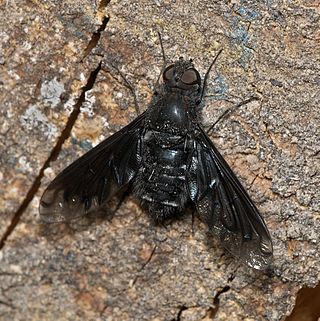
Anthrax is a genus of bombyliid flies, commonly known as "bee-flies" due to their resemblance to bees. Most are dull black flies, and are usually small to medium in size, 4–20 millimetres (0.2–0.8 in), and many species have striking wing patterns.

The Asiloidea comprise a very large superfamily insects in the order Diptera, the true flies. It has a cosmopolitan distribution, occurring worldwide. It includes the family Bombyliidae, the bee flies, which are parasitoids, and the Asilidae, the robber flies, which are predators of other insects.
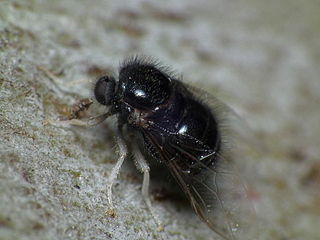
The Acroceridae are a small family of odd-looking flies. They have a hump-backed appearance with a strikingly small head, generally with a long proboscis for accessing nectar. They are rare and not widely known. The most frequently applied common names are small-headed flies or hunch-back flies. Many are bee or wasp mimics. Because they are parasitoids of spiders, they also are sometimes known as spider flies.

Bombylius major is a parasitic bee mimic fly. B. major is the most common type of fly within the Bombylius genus. The fly derives its name from its close resemblance to bumblebees and is often mistaken for them.

Heterostylum is a genus of flies belonging to the family Bombyliidae (bee-flies). There are 14 described species, distributed throughout the Americas. These are robust and very hairy flies with a body length of 10–15 mm. They can be distinguished from similar genera by an indentation in the hind margin of the eye and unique wing venation.

Exoprosopa is a large cosmopolitan genus of flies belonging to the family Bombyliidae (bee-flies), with over 325 described species. The genus parasitizes a wide range of insects, including locust and larvae of wasps.

Balaana is a genus of flies belonging to the family Bombyliidae (bee-flies). There are about seven described species, including three from western Australia. These are robust and very hairy flies with a body length of 10–18 mm (0.4–0.7 in).
Atrichochira is a genus of flies belonging to the family Bombyliidae (bee-flies). There are four described species, two from Southern Africa and two from western Australia. These are robust and very hairy flies with a body length of 10–13 millimetres (0.4–0.5 in), are yellowish brown with a black mesonotum and the stylate part of the third antennal is thickened.
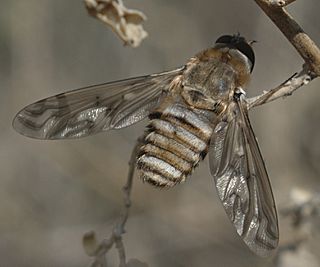
Poecilanthrax is a large, primarily Nearctic genus of flies belonging to the family Bombyliidae.

The Oriental carpenter bee, Xylocopa nasalis, or Xylocopa (Biluna) nasalis, is a species of carpenter bee. It is widely distributed in Southeast Asian countries. It is a major pollinator within its ecosystem, and is often mistaken for a bumblebee. The species leads a solitary lifestyle with a highly female-biased colony in the nest.

Apystomyiidae is a small family of flies containing the living genus Apystomyia and the extinct genera Apystomimus and Hilarimorphites. The single living Apystomyiidae species, Apystomyia elinguis, is native to California. Species of Hilarimorphites have been described from Mid to late Cretaceous Burmese and New Jersey ambers, while the single Apystomimus species is from the Late Jurassic of Kazakhstan.
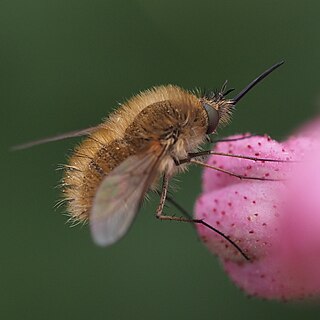
Bombylius canescens, commonly known as the western bee-fly, is a species of bee-fly belonging to the family Bombyliidae.

Anthracinae is a subfamily of bee flies in the family Bombyliidae. There are more than 80 genera and 2,000 described species in Anthracinae.

Brachyanax is a genus of bee fly in the subfamily Anthracinae. It was circumscribed by Neal Evenhuis in 1981. Thirteen species are recognized, and they are found in Asia and Australasia.

Villini is a tribe of bee flies in the family Bombyliidae.
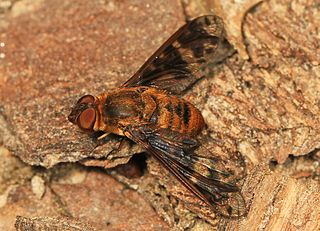
Dipalta banksi, the Huron shore bee fly, is a species of bee fly in the family Bombyliidae.

Dipalta serpentina is a species of bee fly in the family Bombyliidae. It is widespread in North America from British Columbia, Canada south and east through most of the United States to Florida, Mexico, Cuba, Guatemala, and Honduras. It is a parasitoid of antlion species such as Myrmeleon immaculatus.

Euchariomyia is a monotypic genus of the subfamily Bombyliinae. The only species is Euchariomyia dives.

Hemipenthes maura is a species of bee fly belonging to the family Bombyliidae.


















